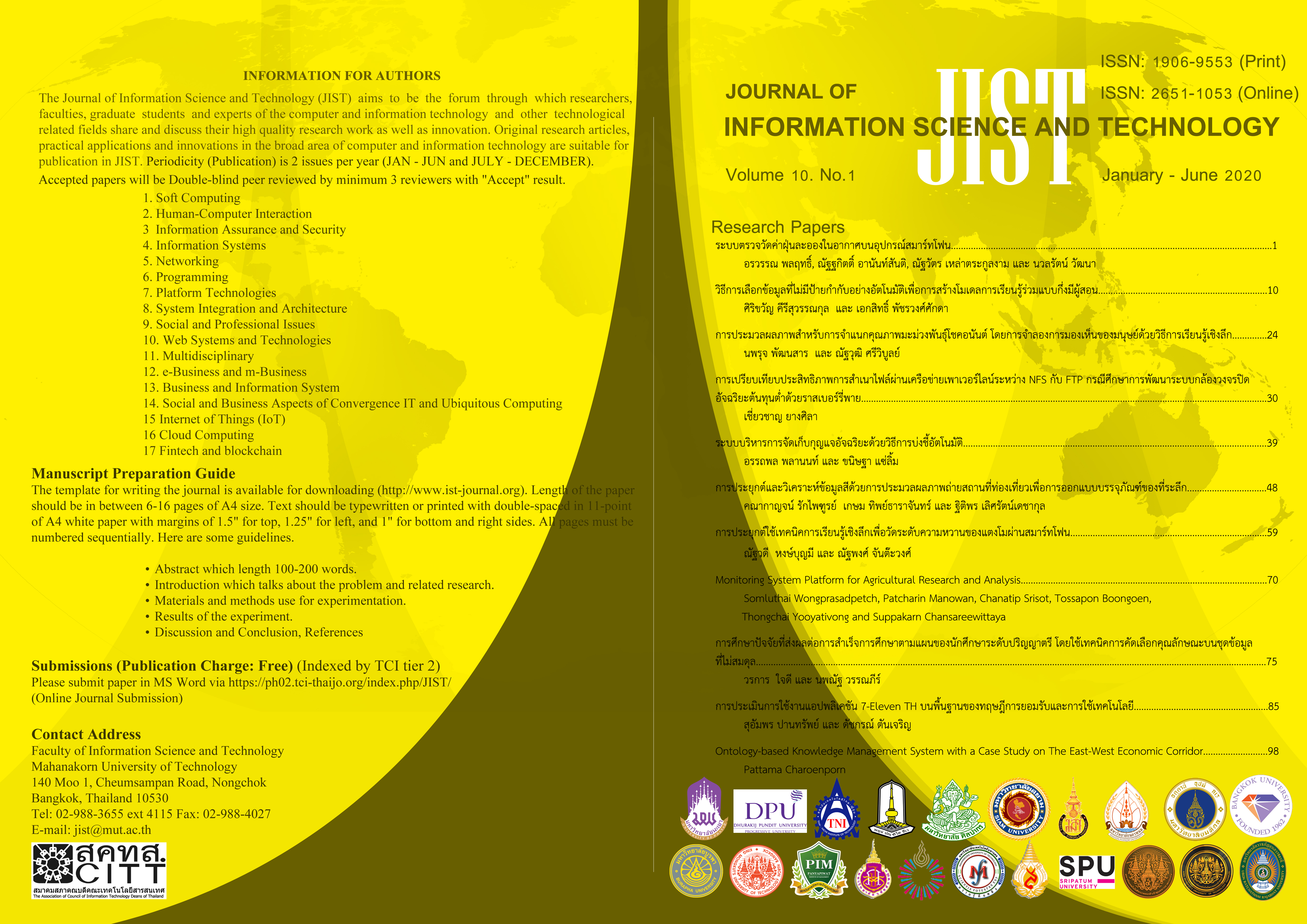The Study of Factors Affecting for On-time Graduation of Ungraduated Student Using Feature Selection Technique on Imbalanced Datasets
Main Article Content
Abstract
The objectives of this research were (1) to study the factors affecting the students' graduation according to the plan, and (2) to study the guidelines and improvements in teaching and learning problems of each subject affecting the graduation according to the plan of the student. Main factors or data in this research, the researcher used the grade point in each subject, GPA, the gender of the first-year and second-year students by collecting data from Computer Information System, Faculty of Business Administration and Liberal Art, Rajamangala University of Technology Lanna, Chiang Mai with a total of 358 records. As a result, it revealed that datasets were imbalanced with a higher number of students who graduated as their plan than students who did not graduate as their plan completely. Therefore, the researcher solved the problem using the method of balancing the data set by Synthetic Minority Over-Sampling Technique: SMOTE before entering the process of analyzing factors by using feature selection techniques which can divide as 3 techniques as follows: (1) Chi-Square Feature Selection (2) Information Gain Feature Selection and (3) Correlation Based Feature Selection. From the result, it was found that the most important and topnotch factor in every feature selection was Computer Programming 1 Subject This subject is an elementary and compulsory subject in the Computer Information System and most students received quite low points in this subject. Which may cause this subject to be topnotch in every feature selection techniques and maybe the main factor affecting graduation's plan of students significantly.
Article Details
This work is licensed under a Creative Commons Attribution-NonCommercial-NoDerivatives 4.0 International License.
I/we certify that I/we have participated sufficiently in the intellectual content, conception and design of this work or the analysis and interpretation of the data (when applicable), as well as the writing of the manuscript, to take public responsibility for it and have agreed to have my/our name listed as a contributor. I/we believe the manuscript represents valid work. Neither this manuscript nor one with substantially similar content under my/our authorship has been published or is being considered for publication elsewhere, except as described in the covering letter. I/we certify that all the data collected during the study is presented in this manuscript and no data from the study has been or will be published separately. I/we attest that, if requested by the editors, I/we will provide the data/information or will cooperate fully in obtaining and providing the data/information on which the manuscript is based, for examination by the editors or their assignees. Financial interests, direct or indirect, that exist or may be perceived to exist for individual contributors in connection with the content of this paper have been disclosed in the cover letter. Sources of outside support of the project are named in the cover letter.
I/We hereby transfer(s), assign(s), or otherwise convey(s) all copyright ownership, including any and all rights incidental thereto, exclusively to the Journal, in the event that such work is published by the Journal. The Journal shall own the work, including 1) copyright; 2) the right to grant permission to republish the article in whole or in part, with or without fee; 3) the right to produce preprints or reprints and translate into languages other than English for sale or free distribution; and 4) the right to republish the work in a collection of articles in any other mechanical or electronic format.
We give the rights to the corresponding author to make necessary changes as per the request of the journal, do the rest of the correspondence on our behalf and he/she will act as the guarantor for the manuscript on our behalf.
All persons who have made substantial contributions to the work reported in the manuscript, but who are not contributors, are named in the Acknowledgment and have given me/us their written permission to be named. If I/we do not include an Acknowledgment that means I/we have not received substantial contributions from non-contributors and no contributor has been omitted.
References
วรการ ใจดี, “ตัวแบบการทำนายผลการสำเร็จการศึกษาตามแผน โดยใช้เทคนิคเอสเอ็มโอทีอีและตัวแบบการเรียนรู้แบบรวมกลุ่ม บนชุดข้อมูลที่ไม่สมดุล สำหรับข้อมูลการสำเร็จการศึกษา,” รายงานสืบเนื่องจากการประชุมสัมมนาทางวิชาการ มหาวิทยาลัยเทคโนโลยีราชมงคลล้านนาตะวันออก ระดับชาติครั้งที่ 12, 2562, หน้า 325-335.
พิชัย ระเวงวัน, “โมเดลเพื่อการพยากรณ์สถานภาพทางการศึกษาของนักศึกษา,” รายงานสืบเนื่องจากการประชุมวิชาการเสนอผลงานวิจัยบัณฑิตศึกษา ระดับชาติและนานาชาติ มหาวิทยาลัยขอนแก่น, 2560, หน้า 273-283.
เบญจภรณ์ จันทรกองกุล, “วิธีการที่เหมาะสมสำหรับการแบ่งกลุ่มข้อมูลที่ไม่สมดุลสูง,” วิทยาศาสตร์ดุษฎีบัณฑิต สาขาวิชาวิทยาการคอมพิวเตอร์. มหาวิทยาลัยบูรพา, 2557.
กิตติพงศ์ ชมบุญ, “เทคนิคการจำแนกประเภทข้อมูลส่วนน้อยบนข้อมูลไม่สมดุลด้วยวิธีการแบ่งข้อมูล,” วิศวกรรมศาสตร์ดุษฎีบัณฑิต สาขาวิชาวิศวกรรมคอมพิวเตอร์ มหาวิทยาลัยเทคโนโลยีสุรนารี, 2558.
อัจจิมา มณฑาพันธุ์, “การเปรียบเทียบวิธีการคัดเลือกคุณลักษณะที่สำคัญในการปรังปรุงการพยากรณ์มะเร็งเต้านม,” Royal Thai Air Force Medical Gazette, 2562, หน้า 49-56.
Zheng Z, Cai Y, Li Y, “Oversampling Method for Imbalanced Classification,” Computing and Informatics, Vol. 34, 2015, pp. 1017-1037.
Beretta L, Santaniello A, “Nearest Neighbor Imputation Algorithm: A Critical Evaluation,” The 5th Translational Bioinformatics Conference, 2015, pp. 197-208.



